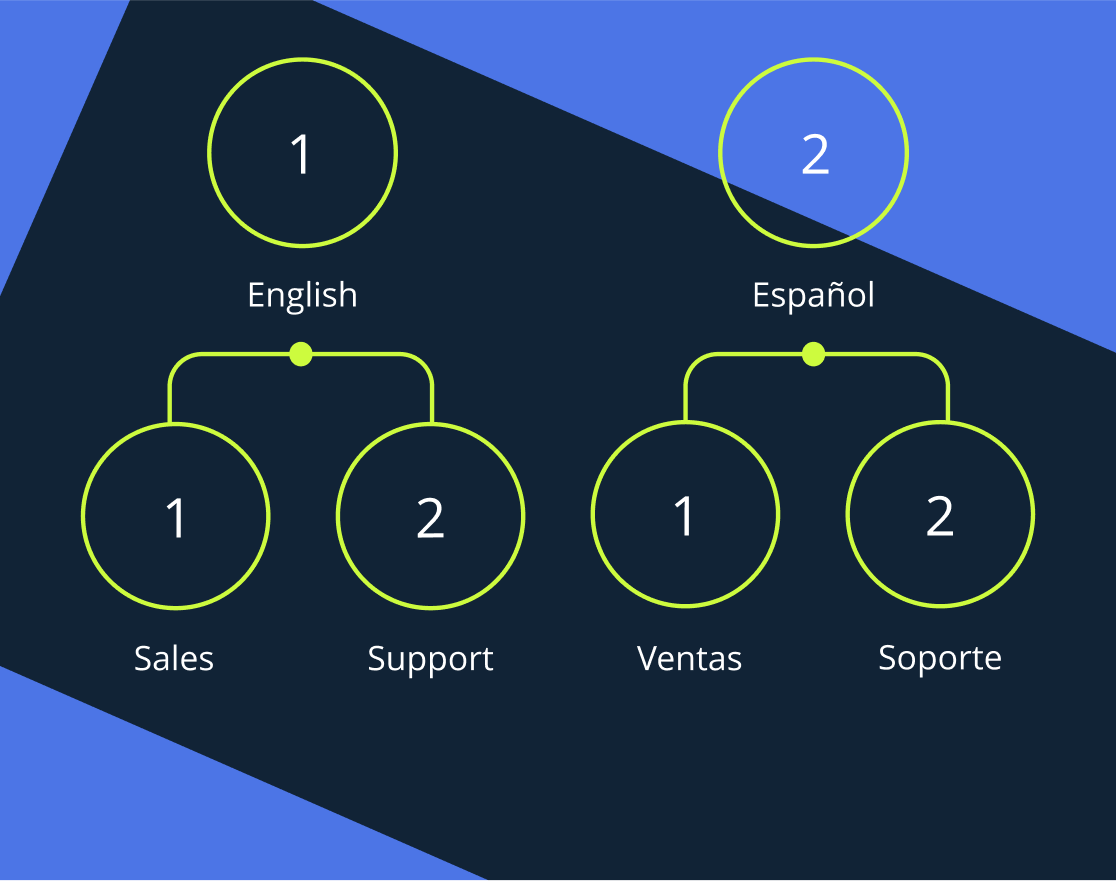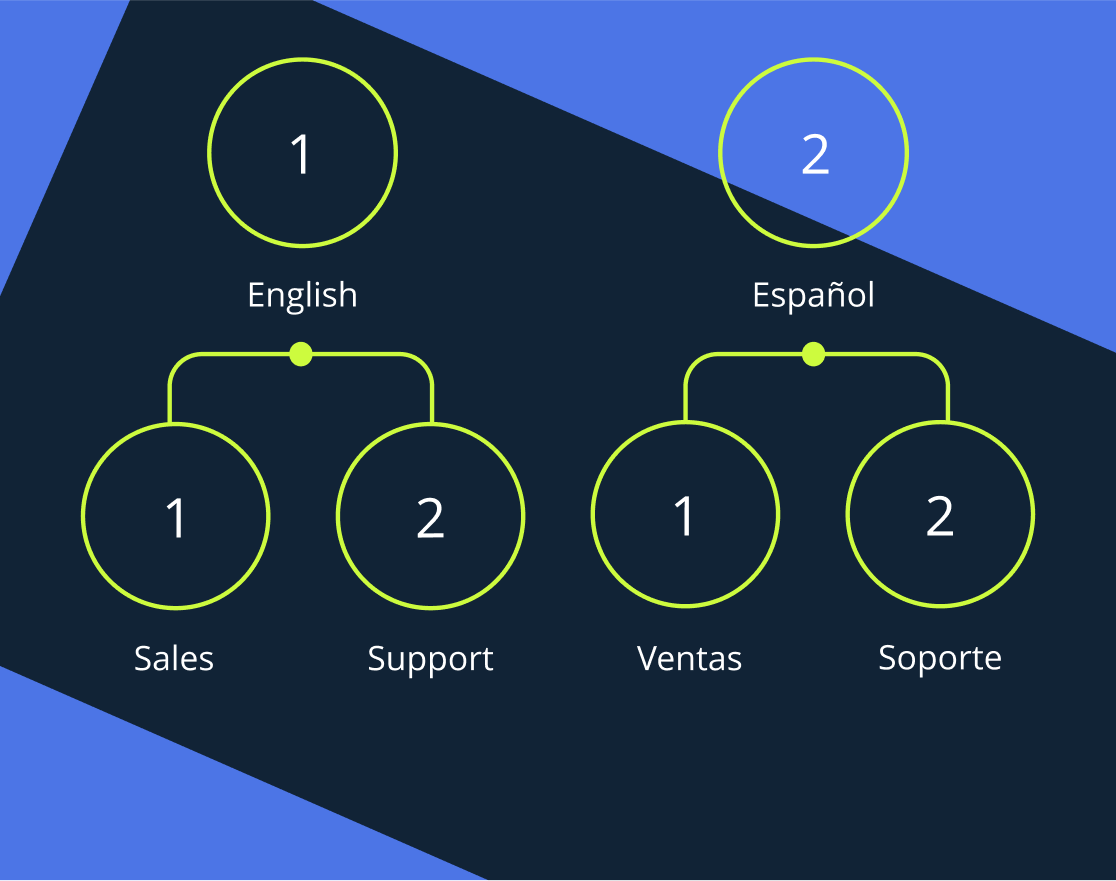Have you ever selected 2 to talk to sales, or pressed 3 to select an option? Then you’ve encountered call center IVR, one of the most helpful communication tools available to modern businesses. With IVR, businesses of all sizes can dramatically increase their level of customer support while decreasing operational costs.
Curious how it all works? Read on to find out!
- What is IVR in a call center?
- How does a call center IVR system work?
- How do you set up IVR for a call center?
- Benefits of using interactive voice response in call centers
- Features of IVR system for call center
- How do call centers use IVR?
- Things to watch out for when using IVR
- Call center and contact center IVR best practices
- IVR technology trends
- Call center IVR systems make businesses better
What is IVR in a call center?
“Interactive voice response” (which is what IVR stands for in call centers) is a calling tool that lets users pick from a menu of options. Think of it as a digital version of a secretary: instead of having a person ask where the caller would like to be connected, they simply “tell” the system by speaking or by pressing an option.
This technology has a lot of potential benefits for call centers. For one, it saves time: you can only have so many actual secretaries. If you have more calls than secretaries, that means people are going to have to wait. But if you use IVR, you won’t. Likewise, it can also save contact centers big money, as it is cheaper than hiring salaried or hourly workers.
How does a call center IVR system work?
IVR customer support works by acting as your “first line of defense.” First, a call comes into your VoIP phone system. Here, the caller interacts with an automated response menu. Depending on how it’s set up, callers may be informed of some information ahead of time – or, you can just plunge them into the options.
By having pre-set the various IVR options available to customers (see later sections for details on how and on best practices), you can provide them with a litany of potential options.
How do you set up IVR for a call center?
The steps will vary depending on the call center software you use, but they will all generally follow a similar pattern. Follow along for help with setting up yours:
- Go to your admin panel: Start wherever your contact center’s call settings are.
- Customize your IVR menu: Decide what you want to have in your menu structure, incorporating multi-level options, self-service features, and intelligent call routing to improve call handling. Decide how many levels and language options you want to have.
- Record voice prompts: If your system offers it, you can record audio for your menu instead of having a default robotic voice (this can be more pleasing for callers).
- Create the Second Level of the IVR: Likewise, if your system allows for this as well, make sure to really get the maximum potential out of your system by allowing your callers to get as specific as possible.
If your system offers customers the ability to return to previous levels (like MightyCall’s system), be sure to utilize that as well.
Benefits of using interactive voice response in call centers
While businesses of all types can take advantage of IVR, call centers in particular can stand to get the most out of using it. That’s because these systems work perfectly with the goals of most call centers (acting as inbound call center software). We get into how below:
Decrease costs
This is the clearest and most obvious reason why contact centers use this service. You already have to have lots of people working for you in various departments; do you want to have to pay for massive amounts of people who essentially just direct calls as well? IVR software for call centers works for you for free.
Keep things flowing
Because IVR systems can be always working, you can ensure that customers are constantly being directed to where they need to go instead of having them all sort of bunch up whilst waiting on hold. This has a “trickle-down” effect, as it keeps a steady flow for other agents, instead of giving them long periods of sitting around doing nothing followed by long periods of intense activity.
Improve customer satisfaction
And speaking of getting customers to where they need to go – IVR systems in contact centers also have the benefit of improving customer satisfaction. While older and slower systems seemed clunky, new systems are popular because they are easy to work with for customers and they get them to where they need to go.
<Organize your incoming callers
Normally, calling is first-come-first-serve. And that may sound fair to the average bear, but in reality, it does not make a lot of sense. Some folks have easy questions that can be answered in seconds, and some have incredibly pressing issues which need to be addressed promptly and can take a while. With call center IVR software, you can organize things in a way which helps your agents to contact certain customers first, followed by others later.
Get it right the first time
Nothing makes customers more frustrated – and hurts your bottom line – more than people having to call back. That’s because they often either do not call back or they call back annoyed. With a phone menu, however, you can make sure they get to where they need the first time, ensuring they get their answers and they hang up satisfied, not having to have sat on hold forever just to hang up and try again in frustration.
Inform your agents ahead of time
Another benefit of using interactive voice response in a call center is that, because your callers are directed, your agents can already have an idea of what they need. When calls come in at random, it can be a bit difficult to know what the person wants. But with precision organization, agents will be able to be prepared (depending on how specific your menu gets, they can be extremely prepared).
Features of IVR system for call center
Of course, you cannot JUST use the IVR call center feature. It works in sync with many others which allow you to maximize all of their potential. In this way, they are greater than the sum of their parts when used together.
- Music on hold: Even with call center IVR, people may still have to wait in line. Make their wait more pleasant with music!
- Custom greeting: Of course, before the music you can play audio. This, when properly targeted, can eliminate callers (for example, if someone selects an option to speak to sales, you could have audio play offering them info on latest sales, potentially answering their question).
- Call queues: Though allowing callers to choose their own adventures will help, keeping them in an orderly line once they’ve chosen will help even more.
- Ring groups: This method of organization can help your callers get the answers they need quickest by ringing entire groups, and keeping things more organized (if you cannot tell, “organization” is an important theme here).
- Call flow designer: Speaking of organization – nothing is more important than organizing the entire call flow. Make it exactly yours – pick when specific audios play, who gets what call when customers pick from options and more – with this feature.
- Call transfer: Sometimes, people pick the wrong option; they may be clumsy, or they may not know they needed another department. This option can help your agents get your callers to where they need to be, without them having to start the whole process over again.
- Live call monitoring: Even with the best organization you can manage, sometimes there are still major jams. Can be that there are a lot of callers, can be that it’s a holiday. Regardless, this feature allows managers to help their agents move things along by keeping watch over what is happening.
There are of course plenty more features you can use to help organize your calls – we are by no means suggesting the above are the only ones you should take into account. The important thing, after all, is that you make it yours.
How do call centers use IVR?
So what can call centers actually do with contact center IVR features? There are tons of uses obtained when using this feature, as it can solve a lot of problems (some you may not even be aware of).
Prepare agents for callers
When people filter themselves via this software, they – when combined with call queues, as we mentioned above – end up in line before agents who are likely specified in a particular type of service (be it customer support, sales, or otherwise). That way your agents *know* what the person calling will need help with, as opposed to being surprised.
Address customers before they speak with anyone
Being able to organize customers with this call center feature also means that you can address them beforehand, with pre-recorded messages or otherwise. The content can directly address potential questions, but they can also be directed elsewhere. For example, someone with a simple question can be directed to your website, saving them (and you) time.
More easily train new call center agents
If you have all calls coming into a generic line, with everyone taking turns to pick up, new call center agents who are supposed to focus on one topic may find themselves addressing another. But when callers come in more organized, new agents will have an easier time learning the ropes for their specific category.
Work off the clock
IVR can benefit your call center in a unique way: it is always working. If you take the time to really flesh out your features properly, you can essentially answer customer questions at any time of day, by having customers direct themselves through a network of friendly audio messages.
Screen for robot dialers
The presence of an interactive voice response system which requires users to select options can have the bonus effect of blocking incoming robot calls, which are not real people and are often just scams or are designed to flood your system. As these “callers” often cannot select options, the call will never get through.
Improve customer satisfaction rates
By giving your agents more information ahead of time, keeping things organized, and providing information to customers before they have even spoken with a person, your customers are going to be happier. They will be more informed, and they will feel more like people and less like just a number.
Things to watch out for when using IVR
Creating a sloppy flow
When people select options in call center IVR systems, they are traveling through a network. With call centers in particular, this network can be rather long – and if their issue is significant, involving multiple departments, they may end up needing to talk to multiple people. Because they are speaking through the phone, it is crucial that every single part of the flow and your menu options are well thought out. If not, they could get sent to places they do not need to go, or even hit a “wall” and disconnect.
But this is avoidable, of course. Make sure to examine all of your settings yourself before you put them into effect – is everything set right? After you check, make sure to test it yourself. Call through and pretend to be a customer with a complex problem – see if you get to where you need to be.
Making it hard to understand
Call center IVR systems need to be simple. A common problem people encounter with is that they do not understand what it is they are being asked. This can be difficult-to-understand categories, or it can be a poorly recorded audio message (if you have elected to use this option).
Avoid this entirely by talking to others about your potential options – do they make sense to others as well as you? Also, pick common words. Instead of “After-Sales Service,” for example, use the far more common “Customer Service.” And when recording, make sure to do so in a quiet space with a good microphone.
Being overly specific
It’s important to get information about your customers so that your agents can be prepared. But if you make people answer too many prompts, they can get annoyed. What department they need? Makes sense. What product they ordered? Makes sense. Their birthday? Probably not necessary for a customer support staffer to know.
Restrict yourself to just the questions which your agents will need to provide the best service possible. If you are a birthday cake company, a birthday question may make sense. But if you are a huge call center, you do not need so much information in the very beginning. That can be figured out down the line.
Front-loading
If you are a customer, you do not want to have to repeat yourself too much. It’s frustrating. This is why it is always a big mistake for contact centers to make customers do so. If a customer has a complex issue, they should not have to explain it multiple times in multiple steps. Each step of the way should build off previous steps, not replace them.
If you are operating a large call center, and it is one which has plenty of agents, organize your call center IVR software so that customers only need to answer what is strictly needed at key times. That way they will not need to restate what they need each time they talk to a new person.
Call center and contact center IVR best practices
Creating a good call center environment with IVR software can sometimes be easier said than done. Here are some best practices to keep in mind when you are using this feature.
- Keep it simple: Design your menu options with simplicity in mind, using clear language and offering only essential options to avoid confusion.
- Keep it private: Do not request too much personal information from callers. Only ask for what is strictly needed for your agents to provide the necessary service.
- Prioritize common requests: Place the most frequently used options at the beginning of the menu to expedite callers’ needs and enhance user experience.
- Provide self-service options: Offer IVR call center solutions for common requests, such as account balance inquiries or order status updates, to reduce the need for agent intervention and boost call center efficiency.
- Use professional voice recordings: High-quality voice recordings ensure a polished and professional customer experience, reflecting positively on your brand image. (MightyCall offers this service)
- Use it to inform: When customers are making their choices, you can inform them – via the aforementioned pre-recorded audio – of ongoing sales or other things which may impact their decision-making.
- Monitor and optimize: Continuously analyze call data and adjust your IVR system to enhance performance, customer satisfaction, and overall call center effectiveness.
IVR technology trends
It’s always hard to predict the future, be it which film genres will be popular or how implementing call center IVR will work. But we can make some educated guesses!
- Reducing agent numbers: In time, call centers are likely going to need to hire fewer workers. That’s because this technology is going to get quicker and more efficient, meaning it will be able to answer even more questions from callers.
- Eliminating numbered options completely: Currently, some systems operate using “Press 1…Press 2…”. In the future, with audio responses able to be done quickly and more easily, people will likely no longer need their number pads.
- AI will change the game: Right now, AI can feel somewhat gimmicky and unreliable. But in the future – sooner than you may think – it is going to be extremely intelligent. And it will play a role in any given IVR system for call centers because it will be able to affect all of our above options. AI will improve audio detection, and it will be able to act as an agent.
Call center IVR systems make businesses better
It’s just that simple. IVR systems help contact centers produce better results for their callers and customers. Such self-service systems improve customer support metrics, they make life easier for your agents, and they make life easier for your clientele.
But when you are shopping around for IVR contact center technology, make sure that you are getting a comprehensive package. Services like MightyCall offer IVR, but they also offer world-class security, a suite of other seamlessly integrated features, and more. Try it out and change the game!


































